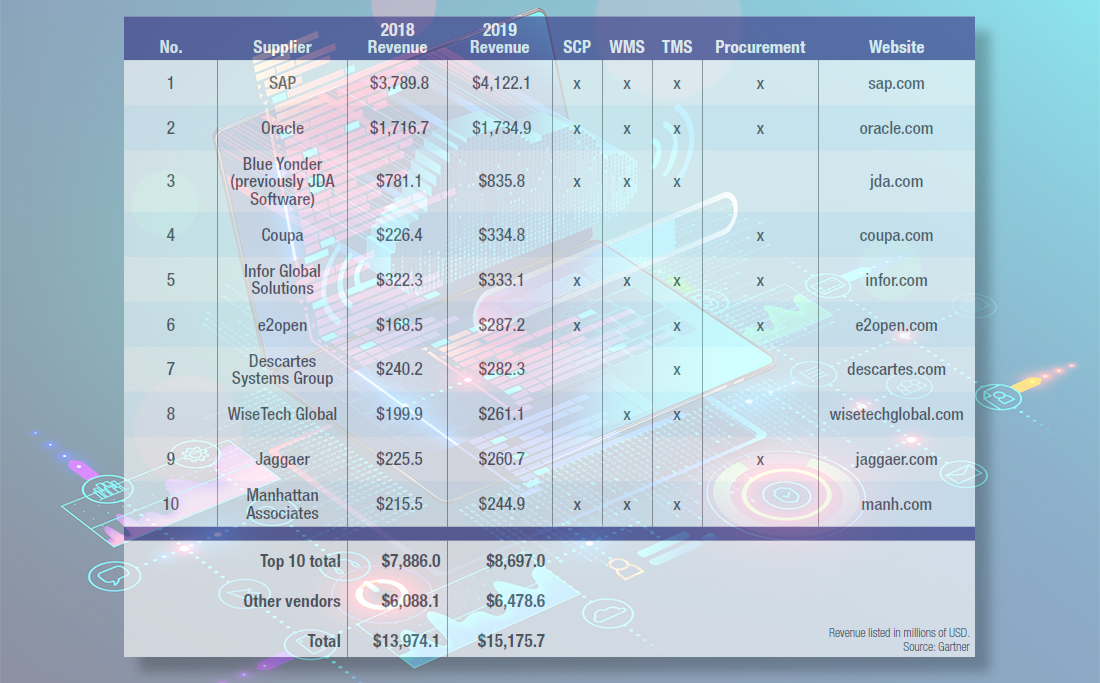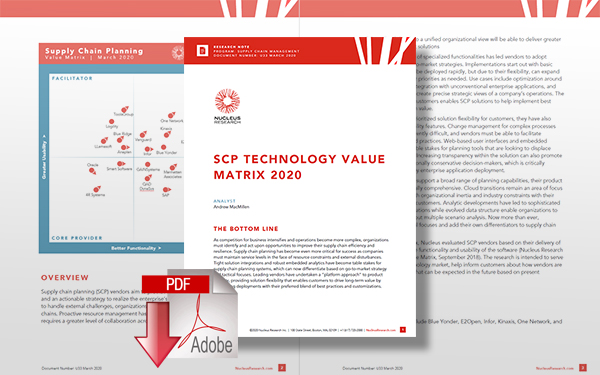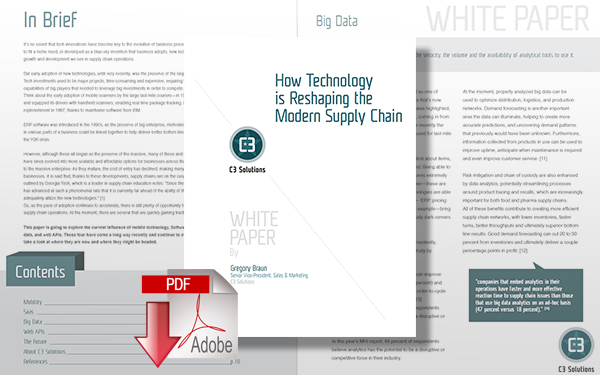The Continuing Convergence of the Public Cloud and Supply Chain Management Software

How Software-as-a-Service (Saas) took over the supply chain software market, where it stands now, and how far we have to go before the supply chain is truly autonomous.
Mainstream Cloud Adoption
Coming into 2020, the worldwide public Cloud Services market was on track to grow by 17% for a total of $266.4 billion in revenues this year - up from $227.8 billion last year.
“At this point, Cloud adoption is mainstream,” Gartner’s Sid Nag pointed out at the time.
“Adoption of next-generation solutions are almost always ‘Cloud-enhanced’ solutions, meaning they build on the strengths of a Cloud platform to deliver digital business capabilities.”
Breaking the Cloud down into two different segments, Gartner said Software-as-a-Service (SaaS) will claim $116 billion of the market in 2020, while Infrastructure-as-a-Service (IaaS) will hit $50 billion.
Gartner attributes much of the growth to the demands of modern applications and workloads, “which require infrastructure that traditional data centers cannot meet.”
Safe to say, COVID-19 will elevate those numbers even further as companies scramble to find technology that supports more remote, socially-distanced work arrangements.
So, while Cloud adoption was already on the rise - with very few companies doing big, on-premise software installations anymore - it’s taking on a larger responsibility as organizations invest in applications that help them be more flexible, agile, and resilient.
Supply chain software has been front-and-center in many of these conversations. Valued at over $15 billion, the supply chain management (SCM) sector grew at an 8.6% pace in 2019, exceeding $15 billion in vendor revenue by helping companies automate and manage their domestic and global supply networks.
According to Balaji Abbabatulla, Gartner senior director analyst of product management research for SCM software, Cloud software revenue grew almost 2-1/2 times faster than the overall SCM market in 2019.
In total, it accounted for nearly 34% of the market as all leading vendors in the space took their new product strategies into the Cloud.
“The impact of Cloud has been all-pervasive across all of the supply chain submarket segments,” Abbabatulla points out. Gartner divides those segments into procurement, supply chain planning (SCP), and supply chain execution (SCE) applications.
For procurement, he says many of the procurement platforms being adopted right now are Cloud-based, and many of their users are accessing those platforms remotely (via the Cloud). “It’s really about usage and adoption,” he says.
Read the Article: Top Challenges and Solutions for Optimizing Procurement & Inbound Supply Processes
In the SCP space, Abbabatulla is seeing a big push for legacy software modernization that’s being supported by the adoption of Cloud-based applications. Much of what’s in place right now is antiquated, so companies are looking for new ways to be able to react quickly across multiple time horizons. Cloud is helping them achieve those goals and more.
“At a broader level, business leaders are looking for tech tools that help them achieve better supply chain resilience - as opposed to finding ways to improve efficiency and productivity,” says Abbabatulla.
“Where efficiency was once a driving force for Cloud-based SCP adoption, now it’s all about resilience.” Credit COVID-19 with driving this trend. Where Cloud was a “nice to have” pre-pandemic, it has since become a “must-have.”
“COVID has made it imperative for supply chain leaders to have some form of a modern planning solution that cuts across various individual functions - be it sourcing planning, execution planning, manufacturing planning or sales and distribution planning,” Abbabatulla explains. “To manage any of these functions, organizations need to be able to understand and react quickly to environmental changes.”
Top 10 Supply Chain Management Software Suppliers
SCM (SCE, SCP, Procurement) Total Software Revenue
Improving Productivity and Efficiency
As the third component in Gartner’s 3-legged SCM stool, SCE is all about improving operational productivity and efficiency. It’s where warehouse management systems (WMS), transportation management systems (TMS), yard management systems (YMS), and others come together to support the overall supply chain. Using the warehouse as an example, Abbabatulla says Cloud-based WMS stands at the intersection of emerging technologies and the need for multi-enterprise collaboration.
“The Cloud allows warehouse applications to integrate with external sources that, in turn, send signals (i.e., a delay or disruption in the upstream supply chain) that help the company in question automatically optimize its own internal processes,” Abbabatulla explains. “As a result, overall internal efficiency improves.”
As Cloud continues to affect all three facets of SCM, Abbabatulla expects to see more companies moving over to this software delivery model. With or without technology, he says all organizations are focused on enabling better decisions by improving intelligence in the supply chain. A trend exacerbated by COVID-19, this movement in and of itself continues to drive the high demand for Cloud-based supply chain software.
Moving Toward the Autonomous Supply Chain
Operating in a world where the ability to make anything “autonomous” is technology’s latest siren call, supply chain managers are envisioning a day when some or all parts of their global supply chain are, indeed, autonomous. The Cloud could help them get there.
Salim Shaikh, a digital transformation executive at Blue Yonder, says the high levels of uncertainty that COVID-19 brought with it are driving even more supply chain operations to explore their autonomous supply chain options. Seeking better resilience and adaptability, more of these companies are looking to the Cloud for help in this area. For many, the “Holy Grail” is the autonomous supply chain or that place where planners can use real-time data to reduce latency, manage disruption and turn their attention to more value-added tasks, like managing exceptions and collaborating with customers and suppliers (versus analyzing data).
For the company that doesn’t want to rip out and replace the on-premise systems that it has been using for decades, the Cloud paves the path to newer, more modern applications that can be integrated into existing enterprise resource planning (ERP) and other systems using application programming interfaces (APIs).
“This allows organizations to leverage new software capabilities and technology like machine learning, artificial intelligence (AI), and predictive/prescriptive analytics,” says Shaikh, “on top of their existing solutions.”
Read Artificial Intelligence: The Potential of Unlocking the Enormous Value of Your Supply Chain Network
Acknowledging that the autonomous supply chain creates predefined scenarios that can be automatically implemented when a particular event is triggered, Abbabatulla says the end goal for such supply chains is that every single supply chain decision should be made and implemented autonomously. And while this is certainly something to aim for in the future, Abbabatulla says we’re not quite there yet, nor is it presently a key driver of Cloud-based SCM investment.
“The autonomous supply chain has long-term business potential,” Abbabatulla concludes, “with supply chain leaders currently investing in applications that improve their business outcomes today, so they can recover from the downturn, gain competitive advantage and grow quickly.”
The Modernization of The Supply Chain
With all of the top supply chain software providers now offering Cloud-based options - and some focusing solely on this delivery model - it’s no longer a question of if a company is going to move in that direction, but when that’s going to happen. As chief sustainability officer and group vice president of SCM product strategy for Oracle, Jon Chorley says COVID-19 has brought to light the value of the Cloud across nearly all software segments, SCM included. For example, he says Cloud go-live implementations can take place 100% virtually, which means no worries about travel, social distancing, or other COVID-related workplace challenges.
The fact that Cloud-based SCM integrates machine learning, AI, IoT, and even blockchain (in some cases), makes it particularly attractive for newer companies, and for those that are saddled with on-premise and legacy systems that lack the modern bells and whistles. With little to no investment being funneled into non-Cloud-based enterprise software platforms at this point, Chorley says the “pendulum has swung” over to the SaaS delivery model.
“Companies are recognizing that some of these newer technology capabilities can really make a difference in supply chains,” he adds, “and they want to leverage them within their own environments.”
Where in the past these add-ons may have required expensive customizations, consulting, and integration work, most are simply built in to the modern, Cloud-based options. “As technology continues to evolve and develop, those capabilities just become part of our solution,” Chorley says. “You can’t go out and integrate them, extend your software, or add them on. They’re part of the intrinsic value proposition.”
5-Year Success Plan
Looking ahead, Abbabatulla sees three phases of supply chain modernization coming. The first is migration to the Cloud (timespan: 2021-2022); followed by process modernization supported by growth technologies such as AI and advanced analytics (2022 and beyond); and finally, we’ll see process augmentation, as companies will implement emerging technologies such as hyper-automation to deploy convergent SCM solutions across their global supply chains in 2023 and beyond.
By the time 2025 rolls around, more companies will have gone beyond just creating specific pockets of intelligence or resilience in their operations, and will be using technology to extend those strengths across the broader supply chain. “By phase three,” says Abbabatulla, “organizations will be getting true value from the investments they made during the first two phases.”
Related Article: The Current State of Digital Supply Chain Transformation
Related Reports/Papers
Supply Chain Planning Technology Value Matrix 2020
In this Technology Value Matrix, Nucleus evaluated Supply Chain Planning vendors based on their delivery of value to customers through the functionality and usability of the software. Download Now!
Digital Supply Chain: The Landscape, Trends, Types, and the Application in Supply Chain Management
In this e-book, you will learn what is the digital supply chain, what is the state of the digital supply chain, and what are the trends and technologies, as well as the application for a more effective supply chain management process. Download Now!
How Technology is Reshaping the Modern Supply Chain
This paper explores the influence of rapidly evolving technologies that have recently come a long way and will continue to transform the supply chain in the years to come. Download Now!
More Resources on Supply Chain Software
Article Topics
One Network Enterprises News & Resources
Blue Yonder announces an agreement to acquire One Network Enterprises for $839 million Blue Yonder Acquires One Network Enterprises for $839M Companies Need to Develop New Innovative Approaches to Supply Chain Design How to Improve Cost of Goods Sold Horizontally Across the Supply Chain How the Global Pandemic Accelerated Supply Chain Visibility, Digitalization, and Automation AI and Data, the Future of Supply Chain Management AI and Supply Chain Problem Solving More One Network EnterprisesLatest in Supply Chain
Spotlight Startup: Cart.com Walmart and Swisslog Expand Partnership with New Texas Facility Nissan Channels Tesla With Its Latest Manufacturing Process Taking Stock of Today’s Robotics Market and What the Future Holds U.S. Manufacturing Gains Momentum After Another Strong Month Biden Gives Samsung $6.4 Billion For Texas Semiconductor Plants Apple Overtaken as World’s Largest Phone Seller More Supply ChainAbout the Author



















